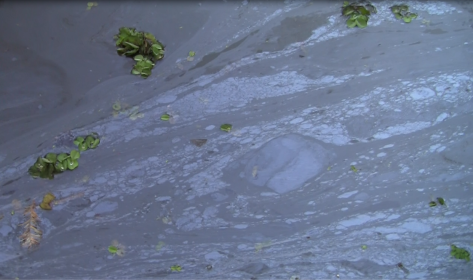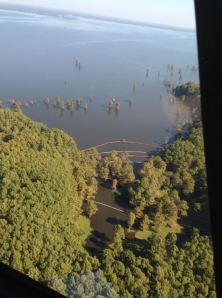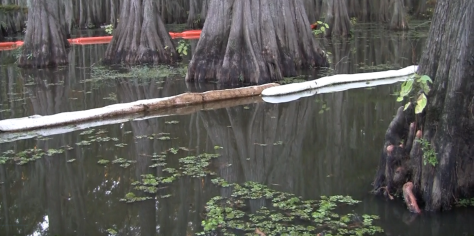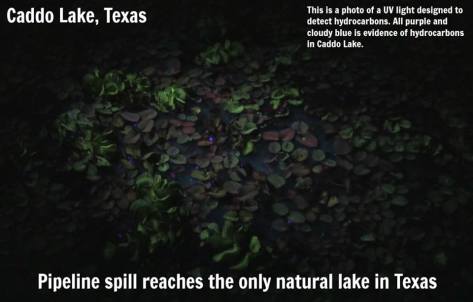
Last month a major pipeline oil spill near Mooringsport, Louisiana sent oil into a tributary of Caddo Lake, which straddles the border between Texas and Louisiana. Despite assurances from officials that oil has not reached Caddo Lake, the findings from an investigation by a community organization contradicts officials’ statements.

Sunoco Logistics Partners’ Mid-Valley Pipeline ruptured on October 13th and sent thousands of barrels of crude oil onto acres of private property and into Tete Bayou, a waterway that feeds into Caddo Lake. The oil spill prompted the evacuation of three households. Officials say the oil sheen stretches 4.2 miles and stops less than a mile away from the mouth of Caddo Lake, which is the largest natural lake in Texas and a major source of drinking water for thousands that live in the surrounding area.
Sunoco Logistics initially estimated that about 4,000 barrels, or 168,000 gallons, of oil leaked from the 20-inch pipeline, but earlier this week Sunoco revised the amount of oil spilled to 4,500 barrels, or 189,000 gallons. The Mid-Valley Pipeline is 65-years-old and stretches 1,000 miles from Longview, TX to refiners in Ohio and Michigan.
On Monday evening , Sunoco’s spokesperson Jeff Shields put out a statement that doubled-down on the companies position that oil had not reached the lake.
“The US Environmental Protection Agency and Sunoco Logistics today inspected absorbent booms that were placed in Caddo Lake as a protective measure against the spread of oil into the lake. Inspection of the booms by the EPA has found that the absorbent material was stained naturally from lake water but there was no oil in, on or around the booms.”

This statement was a response to allegations by Tar Sands Blockade, an anti-Keystone XL community organization, who visited the area last week and posted photos and video on there website of what appears to be oil stained boom where Tete Bayou feeds into Caddo Lake.
Kathy DaSilva, a member of Tar Sands Blockade, and a colleague canoed to the site last Wednesday to see if Sunoco’s claims about oil not reaching the lake were true, and they were surprised by what they found.
“We paddled in a canoe for 30 minutes to the mouth of Tete Bayou,” said DaSilva. “When we were crossing the lake we didn’t smell oil, but when we got out to cross some boom and walked around in the muck we started smelling it really bad. It was burning our nostrils.”
At the entrance of Caddo Lake, along the tree line, DaSilva documented absorbent booms tied to trees, but she says water was still able to go underneath some of the booms.

“Whether oil is at the top or the bottom, it’s in the lake,” said DaSilva. “The area we were in there were no water bugs, turtles, frogs, nothing. For four hours.”
Sunoco reports that nearly 500 dead animals have been collected. Most of which are fish, reptiles and crawfish. At least 41 animals have been cleaned and released.
“For them to say 500 dead animals, that’s only the one’s they’ve found,” said DaSilva. “The numbers are wildly inaccurate. The animals are not just dying in front of workers.”
One of the main concerns for DaSilva are catfish, because they are bottom feeders and a popular fish among anglers. If oil gets submerged and stuck on the bottom of the lake it could prove deadly for a variety of wildlife. So far, Sunoco has recovered about 3,500 barrels of oil from the bayou, but that number fluctuates because the oil is mixed with water.
The pair also brought a UV light with them that can detect hydrocarbons, DaSilva said, “and we saw bright purplish, blue dots that look like the oil has been broken up. Everything we are seeing is consistent with the use of dispersants.”

I emailed Sunoco’s spokesperson Jeff Shields about whether or not chemical dispersants were used in the clean up process, but he still has yet to reply.
Remediation and restoration of the spill is expected to take months, if not years. Although the majority of the oil has been collected, there’s no doubt that some of the oil has sunk into the mud and crawfish holes, making it extremely difficult to clean.
This is the second major oil spill from the Mid-Valley Pipeline this year alone. A 20,000 gallon oil spill happened near Cincinnati, Ohio earlier this March in a nature preserve. Sunoco is still in the process of remediation for that spill.
Despite the fact that the cause of the spill remains unknown, the Pipeline and Hazardous Material Safety Administration, PHMSA, the federal agency that regulates pipelines, allowed Sunoco to restart the pipeline and resume operation at 80 percent of maximum operating pressure.
For DaSilva, Caddo Lake is special. She has been going there since the 1970’s when she was attending college at Stephen F. Austin University, and she says it is her favorite place to canoe.
“They’ve already restarted the pipeline although they don’t know how it leaked,” said DaSilva. “It’s frustrating because regular people like us shouldn’t have to be doing this. We don’t have an agenda other than not seeing a place we love destroyed.”
Click here to see some of the footage Max shot of the spill.


